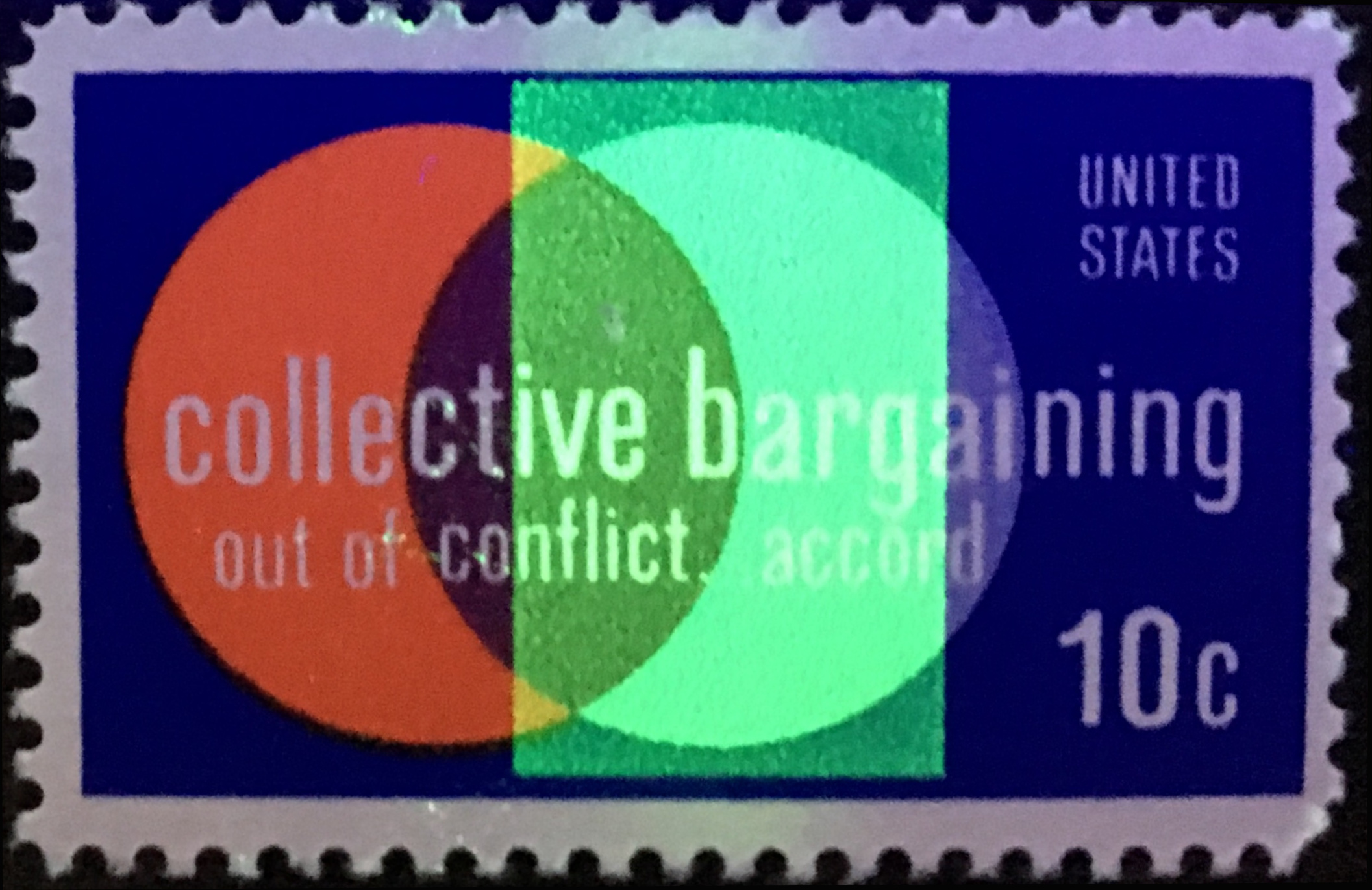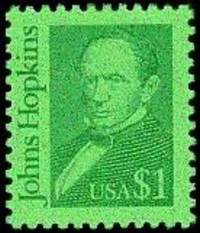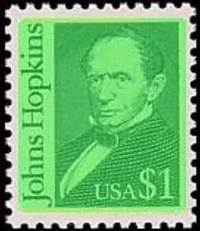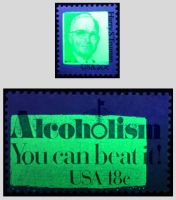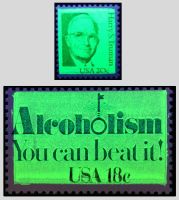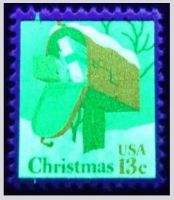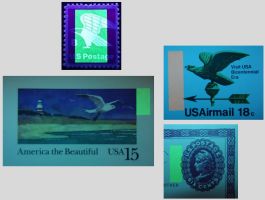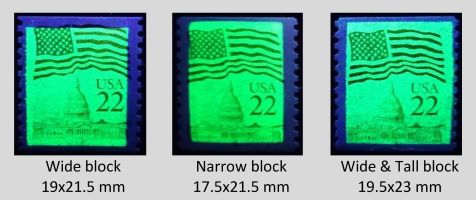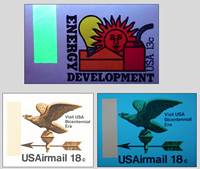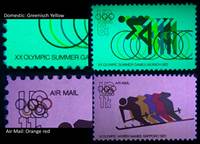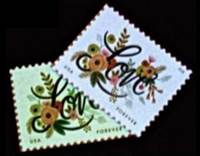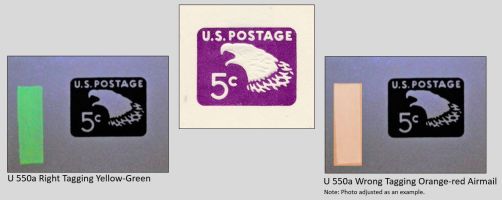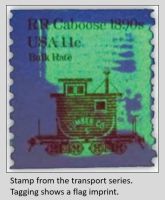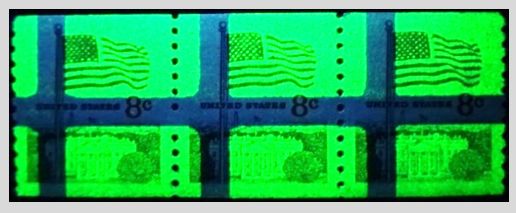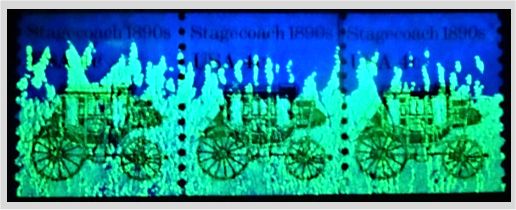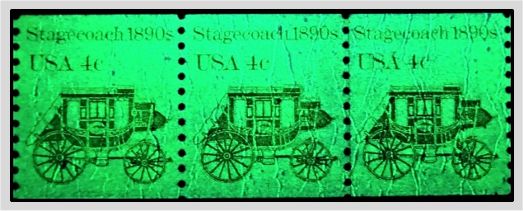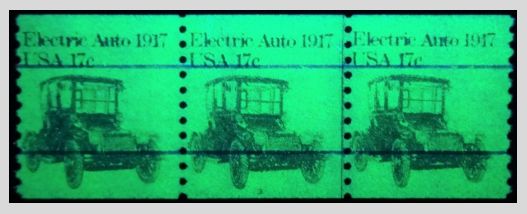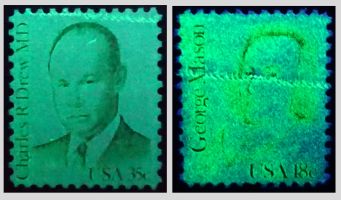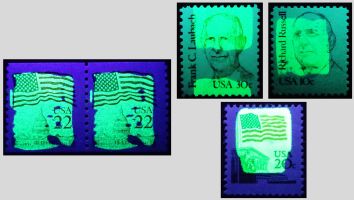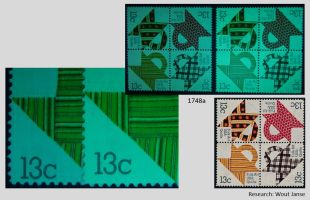US Tagging & Luminescence
Community Project
Mark Stockburger - Administrator
Al Gore, Hans van Gils - Contributors
Don Denman - Developer
Types of UV Light
Ultraviolet light (UV) is form of the electromagnetic spectrum that is adjacent to and greater in energy than visible light. The ultraviolet spectrum ranges from 180 to 400 nanometers (nm) and is divided into three categories: shortwave, mediumwave, and longwave.Shortwave UV light extends from 180 to 280 nm with a peak in energy at about 254 nm. For best results the shortwave UV source should be appropriately filtered (not unfiltered). Ultraviolet equipment that produces light in the shortwave region is typically used for toxicology, fluorochemistry, and germicidal applications. It is also used for identifying US stamp tagging.
Mediumwave UV light extends from 280 to 320 nm with a peak in energy at about 312 nm. Mediumwave UV lamps are generally used in electrophoresis documentation procedures and to identify minerals by their fluorescent response.
Longwave UV light, or black light, extends from 320 to 380 nm with a peak in energy at about 365 nm. Longwave UV is often used in leak detection (in conjunction with fluorescent dyes) and is useful for mineral studies. This is best for identification of Great Britain Machins and for US papers.
As the postal service grew and evolved, the speed and efficiency of the cancelling process became paramount. Automated cancellers required the mail piece to be properly orientated so the cancel could be applied correctly. As a repetitive task, this was well suited for a technology solution. The US Postal Service began experimenting with fluorescent compounds sometime around 1954; these compounds were primarily phosphor based and glowed when exposed to ultraviolet (UV) light. By applying the fluorescent compounds (called tagging) to the stamp, special equipment could then detect the corner the stamp was in and orientate the mail piece properly for cancelling. Tagging is typically invisible to the human eye.
The first regular production US stamp with tagging was the 1963 8¢ Airmail issue #C64a and was followed with the first commemorative stamp tagged stamp: 5 cent City Mail Delivery issue #1238. Since that time hundreds of US stamp have been issued with tagging and some stamp were issued in both tagged and un-tagged versions. This was sometimes due to a stamp first being issued un-tagged but later in the production run tagging was added. These were not ‘errors’ but rather just normal varieties of the same stamp issue. But note that ‘tagging omitted’ errors do exist for stamp which were only issued in tagged form.
The postal service used three basic methods for making a stamp tagged; tagging could be applied on top of the printed stamp, it could be mixed with paper pulp, or it could be mixed with the printers ink. Tagging also was applied to the stamp in several different ways. One method was a continuous tagging where the taggant was applied from edge to edge of the sheet of stamps. Another method is called block tagging where there are untagged gaps between the tagged areas. Block tagging was used to prevent the abrasive taggant from prematurely wearing the perforating pins.
To detect tagging on US stamp an ultra-violet (UV) light is essential. Many UV lights have both short-wave filter or a long-wave filter and these are ideal for most collectors; the short wave detects the type of tagging and long-wave detects paper types used for printing a stamp.
Tagging Types
Click On Images Below to See More
-
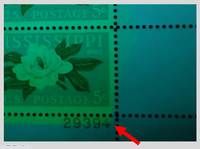
Overall tagging (OT) - Type OP (Offset Press)
- Only with multi-color stamps from the Giori press.
- Recognizable by parts without Tagging in the Margins.
- Three variants:
- OP 1: two-sides in Margins free of Tagging, round corner.
- OP 2: as OT Type II, with one margin-free from Tagging.
- OP 3: as OT Type III, Margins fully Tagged.
-
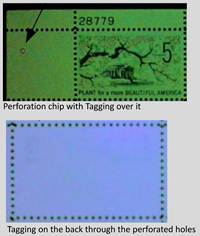
Overall tagging (OT) - Type TAP (Taged After Perforation)
- Tagging is applied after the perforation
- To prevent an imminent shortage of "Tagged" stamps, the USPOD printed previously untagged stamps with a layer of phosphor ink. Such as: Sc.1314a and 1318a.
- Luminescent material (Tagging ink) flowed through the perforated holes to the back of the sheets.
- With unused stamps this variety can be detected with »SWUV lamp.
-
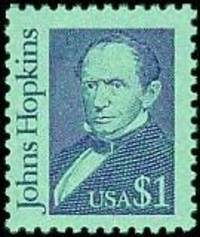
Prephosphored Uncoated Paper with Embedded Tagging
- EP = Embedded phosphor paper
- ET = Embedded Tagging
- UP = Uncoated paper
- Paper without coating layer on which Tagging has been applied
- The Tagging can penetrate the untreated paper
- Variations (Tagging appearance) include Mottled or Grainy appearanceClick Here To See Additional Appearance information
-
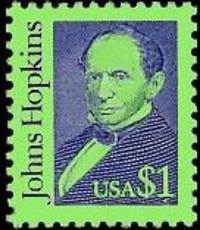
Prephosphored Coated Paper with Surface Tagging
- SP = Surface Phosphor Paper
- ST = Surface Tagging
- CP = Coated paper
- Paper coated substance that requires less ink to print since less absorbent on which the Tagging has been applied
- The Tagging cannot penetrate the paper
- Variations (Tagging appearance) include Smooth, close and even distribution, Solid (‘Even’), Dense and grainy, Solid Grainy Tagging, Uneven, Uneven TaggingClick Here To See Additional Appearance information
-
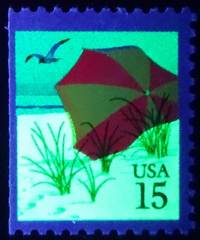
Added To Color (AC) Tagging
- The Tagging has been added to the printing ink
- Occurs with a number of stamps and postal value
- Is not always mentioned by Scott accordingly, sometimes as "Tagged" and sometimes as "Luminescent Ink"Click Here To See Added To Color Postal Stationery #U107 example
Click Here To See Added To Color Postal Stationery #UC37 example
Click Here To See Added To Color Postal Stationery #UC43 example
-
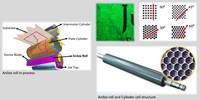
Screen Tagging
- Result from the Anilox roll
- Anilox roll has millions of small cells
- Different engraving angles
- There are three types of Screen Tagging;
Click Here To See Overall Screened Tagging #1 example
Click Here To See Overall Screened Tagging #2 example
Click Here To See Large Block Screened Tagging example
Click Here To See 25c Honeybee Tagging Varieties example
Click Here To See Screen Image Tagging example
-
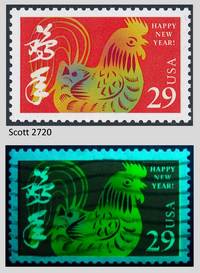
Miscellaneous Tagging - 29c Rooster #2720
- All stamps have Prephosphored coated paper with surface tagging and an Uneven appearance
- Tagging variation Type 2: Extra Block Tagging on top
- Tagging variation Type 3: The pattern of the rooster (Intaglio) printed on the Block Tagging
- Tagging variation Type 1: No Block Tag (Found at Plate No. A5 7333), On closer inspection it is no longer considered a "type" but as Error: Tagging Omitted
Click Here To See Type 2 and Type 3 examples
-
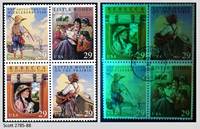
Miscellaneous Tagging - 29c Classic Books #2785-#2788
- Prephosphored coated paper with surface tagging, with an uneven (Uneven) appearance.
- Tagging variation Type 1: An Extra Solid Block Tagging on Little Women and Rebecca stamps.
- Tagging variation Type 2: As Type 1 plus Extra Screened block Tagging on Finn and Little House stamps
- Tagging variation Type 2a: As Type 2 but less easy to see extra Screened block Tagging
- Tagging variation Type 2b: Extra Screened block Tagging on all stamps
Click Here To See Type 1 and Type 2 examples
Tagging Colors
Click On Images Below to See More
-
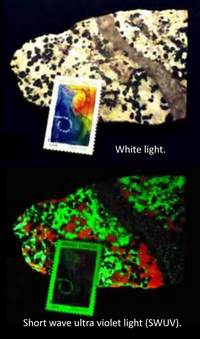
Tagging Color Varieties
- Color variations of tagging arise through the use of different substances and processes
- Example: Scott B1 Breast Cancer Semi-postal
Tagging with Zinc Orthosilicate
A gray powder, some bright yellow-green light under short wave ultra violet light
Zinc Orthosilicate comes from a mineral: Willemiet
- Willemiet is named by the discoverer after the Dutch king Willem I. The French mineralogist Armand Lévyont Covered in 1830, when William I still ruled over Belgium, the mineral in a Belgian zinc mine.
- Willemiet is mined in the town of Franklin, New Jersey (US) and can also be found in Namibia
-
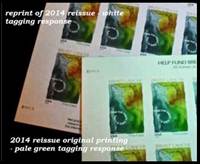
Tagging Color SemiPostal Varieties
- Sep. 30, 2014: Breast Cancer Semi-postal reissued (Reissues), by Sennet Security Products (SSP), Pl # S111111
- Included in Scott as No. B5 and B5a imperf
- The Tagging light green. Less bright than the B1 from 1998
- Oct. 5, 2015: The 2014 SSP issue reprinted (Reprint) at the Banknote Corporation of America (BCA) location, pl # B111111
- The Tagging of this BCA reprint has a clear cream-white appearance
- No unique Scott number and not listed in Durland
-

Tagging Color Personal Computer Postage Varieties
- Color differences and intensity
- Difference in tagging (Bar and Overall)
Click Here To See Additional Personal Computer Postage Tagging Examples
Tagging Errors, Freaks & Oddites
Click On Images Below to See More
-
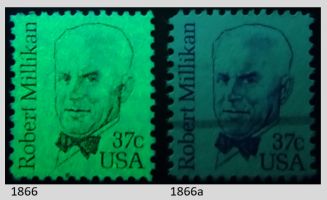
Tagging Omitted
- The lack of Tagging, also called Untagged Error
- Tagging must be completely missing (100%)
- Most not rare
- Listed in Scott as "sub-number"
- Causes:
Tagging on entire sheet or part of print run not applied
Tagging shifted, part of sheet tagging not applied
Click Here To See #2194 Tagging Omitted Example
Click Here To See #2168 and 2191 Tagging Omitted Examples
Click Here To See #1447 Tagging Omitted Example
Click Here To See #2170 Tagging Omitted Example
Click Here To See #2170a Tagging Omitted Example
-

Tagged Errors
- Formally an issue without Tagging, but produced with Tagging
- Often difficult to see
- Tip: several copies under the lamp
Click Here To See #2627 Tagging Error Example
-
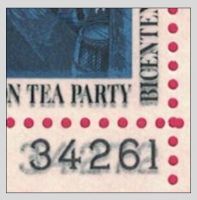
Tagging Ghost
- Ghost image caused by Tagging
- Concerns extra print of a part of the stamp image or plate number
- Stamps printed on rotary presses
- This second image is printed vaguely
- Cause: The Tagging took up some of the not yet dry printing ink. This combination was transferred to the following sheets via the ink rollers
- This term should not be confused with 'Ghost Tagging Images'
-
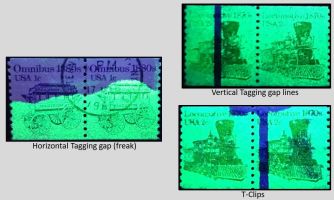
Tagging Freaks & Oddities - Tagging Gap
- Parts or bridges where tagging is missing
- Causes:
Production processes
Too little applied Tagging ink (production error, freak)
Gaps in tagging mats, part of normal process
Click Here To See #5260 and #5261 Tagging Gap Examples
-
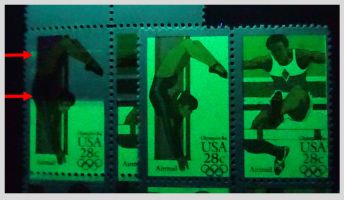
Tagging Freaks & Oddities - Missing Tagging
- Occurs frequently in sports stamps from 1983-84
Click Here To See Additional Example
Paper Fluorescence On Modern US Stamps
By Mark Stockburger
Many types of papers have been used in the printing of US stamps. These papers can be identified and classified by their levels of fluorescence and what they look like under Long Wave (LW) UV light. The paper used can vary from issue to issue and within the same issue. Paper can be classified in one of the following seven types.
1. Dead paper (Dead)
2. Non-Fluorescent (NF)
3. Dull Fluorescent (DF)
4. Low Fluorescent (LF)
5. Medium Fluorescent (MF)
6. High Fluorescent (HF)
7. Hi-brite (HB)
For LF, MF and HF paper, the fluorescence viewed is typically produced by very fine thread like fibers embedded in the paper. These fibers termed “luminescent fibers” glow brightly a bluish white when exposed to LW UV light. The concentration of luminescent fibers is what determines if a paper is LF, MF or HF. In all seven fluorescence classification types, luminescent fibers can be present. For Dead, NF and DF the concentration is low enough that the luminescent effect is not visible from a distance. A description of each paper type follows.
Dead Paper
Dead paper appears dark purple, purplish gray, dark brown, dark grey, or dark blue grey under the UV lamp.
Non-Fluorescent Paper (NF)
NF paper appears brown, gray, lighter blue grey or lighter purple. It may contain some very sparse and randomly distributed luminescent fibers.
Dull Fluorescent Paper (DF)
DF paper appears grayish white, light gray, ivory, yellowish ivory, whitish & very light violet. DF paper contain luminescent fibers, which are typically very sparse in density across the entire stamp.
Low Fluorescent Paper (LF)
LF paper appears a dull bluish white, grayish white or white and is not particularly bright when viewed from a distance. Up close under magnification, the paper will be various shades of gray or brown with a low concentration of luminescent fibers evenly distributed across the stamp. The luminescent fibers are responsible for the fluorescence.
Medium Fluorescent Paper (MF)
MF paper appears almost exclusively bluish white and is fairly bright when viewed from a distance. Up close under magnification, the paper will be various shades of gray or brown with a medium concentration of luminescent fibers evenly distributed across the stamp. The luminescent fibers are responsible for the fluorescence.
High Fluorescent Paper (HF)
HF paper appears exclusively bluish white and is bright when viewed from a distance. Up close under magnification, the paper will be various shades of gray or brown with a high concentration of luminescent fibers evenly distributed across the stamp. The luminescent fibers are responsible for the fluorescence.
Hi-Brite Paper (HB)
HB paper is very bright and bluish white in color when viewed from a distance. The fluorescence is uniform in distribution and is not derived solely from the presence of individual luminescence fibers like LF, MF and HF paper. It is very distinct from other types of paper. Compare it against typical printer paper for a reference.
Coil Paper & Gum Type Designations
The Plate Number Coil Study Group has defined a classification of paper types for coils as follows: Type I, Type Ia, Type II, Type IIa, Type III, Type IIIa, Type IIIb, Type IIIn, Type IV and Type Vn. These classifications have been utilized in this Tagging Project for paper types.
Paper Type I
When exposed to LW UV light this paper will show some presence of optical brighteners in varying degrees of brightness. Color of paper under LW can range from dull purple to bright purple-white. Some brightener is always present, even if only as small luminscent fibers. Backlighting can be used for identification since it has a 20° crisscross pattern, though some Type I stamps show no criss-cross pattern. The gum has 45° diagonal gum ridges.
Paper Type I
When exposed to LW UV light this paper will show some presence of optical brighteners in varying degrees of brightness. Color of paper under LW can range from dull purple to bright purple-white. Some brightener is always present, even if only as small luminscent fibers. Backlighting can be used for identification since it has a 20° crisscross pattern, though some Type I stamps show no criss-cross pattern. The gum has 45° diagonal gum ridges.
Paper Type Ia
A smooth-textured trial gum found on examples of 20c Consumer Education coil P# 1 & 2 and 18c Surrey from P# 9, 10, 13 & 14.
Paper Type II
When exposed to LW UV this paper will appear “Dead” with a color of brown/yellow-brown with no optical brightners or luminescent threads. Gum texture is smooth in with faint horizontal striations in appearance. The paper has a rough surface texture viewed from stamp face. Backlighting is can be used to identify this paper since it has a 45° criss-cross pattern.
Paper Type IIa
Type II has all the same characteristics as Type II accept for gum texture. Gum texture has striations that are distinctly heavy appearing as evenly spaced horizontal ridges.
Paper Type III
When exposed to LW UV this paper will appear “Dead” with a color that is a darker, deep purple-brown color when compared against Type II. Backlighting will show no diagonal paper texture appearing smooth and uniform. Gum texture is stippled or a wavy horizontal pattern. The paper has a smooth surface texture viewed from stamp face compared to other paper types.
Paper Type IlIa
This paper can only be differentiated by its gum, which is uniformly smooth and yellowish next to Type II gum.
Paper Type IIlb
The gum on this paper is fairly smooth with subtle horizontally oriented striations. A strip of three or more stamps makes viewing the striation patterns much easier since the striations fade in and out across the gum surface.
Paper Type IIIn
The distinct characteristic is the gum, which has subtler ridges running at an approximately 56° angle.
Paper Type IV
This paper was the first phosphored paper used on the Transportation Series and the first phosphored paper with dull gum. The gum is uniformly smooth in appearance. This paper is only found on the 23c Lunch Wagon P# 2 & 3.
Type Vn
This paper has diagonal gum ridges like Type I or Type IIIn with embedded phosphor appearing mottled in shortwave UV. It is only found on the 23c Lunch Wagon P# 3.
